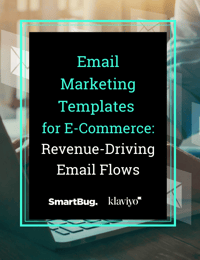
Email and SMS messaging are two key components of an e-commerce marketing strategy. But you can’t just write and design great messages and send them out to your recipients, as nice as that would be!
Deliverability—or the delivery of a text message or email to a recipient—requires that messages go through a process to actually arrive in an inbox or on a mobile device. However, if the processes aren’t properly followed, your email might be filtered into spam or never arrive to a customer’s phone.
So, how does deliverability work? What do filters look for in your message? How can you ensure high email and SMS deliverability? We’ve got your answers below!
What Is Deliverability? How Does It Work?
Deliverability is the successful delivery of a message to a recipient. This term is generally used when discussing email messages and SMS messages.
Although deliverability looks fairly similar when discussing either type of message, there are a few key differences. Let’s take a look.
Email Deliverability
You might have heard two terms that sound pretty similar but have subtle distinctions. Let’s differentiate:
- Email delivery is when an email is delivered to an email service provider (ESP).
- Email deliverability is when an email is delivered to an inbox.
It’s important to distinguish between the two because success is measured differently. You might be successful with email delivery but unsuccessful with email deliverability.
The step-by-step process for successful email deliverability looks something like this:
- When you send your message from an application programming interface (API), the message is first received by the ESP.
- The ESP then immediately places your message in a filter.
- This filter determines whether the email should go to the recipient’s inbox or the spam folder.
We’ll go into what a filter looks for in the next main section. But first, let’s take a look at SMS deliverability.
SMS Deliverability
Similar to email deliverability, SMS deliverability is when a message reaches the intended mobile device.
There are three contributors involved that determine a message’s deliverability:
- Your SMS marketing platform: Most platforms have a set of checks to ensure that your message aligns with the platform’s policies. For example, Klaviyo requires that you have consent from the recipient to send them SMS marketing messages.
- The wireless carrier: Much like an ESP, wireless carriers have their own set of checks, such as terms used in the messages, URLs and links, and who the message is coming from.
- The recipient’s phone or mobile device: After the message has been approved by the wireless carrier, the message will arrive to the recipient’s phone. Delays could occur if the phone is off or service is unavailable.
What Do Filters Look For?
For both SMS and email, filters search for specific aspects of a message that could cause a message to be blocked. Although this might not seem very consequential at first, over time, ESPs could filter your brand under what are known as:
- Whitelists, which are positive lists of approved email senders that do not have a history of sending problematic messages
- Blacklists, which are negative lists of untrustworthy senders that do not reach recipients’ inboxes due to past problematic messages
In order to uphold a good reputation with an ESP, ensure that you’re avoiding the following:
- Bought email addresses: As a general rule, don’t buy email lists. Instead, ensure that you have the recipient's direct consent.
- Unsubscribes: Too many unsubscribes could suggest your emails are unhelpful or irrelevant to the recipient. Although you are less in control of this item compared to others, you can attempt to keep unsubscribes low by following email best practices.
- Spam triggers: Subject lines in all caps, red lettering, too many exclamation marks—these are all token signs of a spammy email.
- Sending to unresponsive users: Maintaining good email list hygiene isn’t just a good way to ensure you’re interacting with people who will buy from you. It’s also a best practice to ensure you’re staying on the good side of an ESP filter.
- Image-heavy emails: Although they might look pretty, image-heavy emails tend to be less informative than text-focused emails.
With SMS, you’ll want to follow a similar set of principles. Generally, deliverability is most affected by the mobile device, invalid numbers, or issues with the telecom provider.
Ready to learn how our e-comm marketers can help you? Get in touch!
How Can Deliverability Be Improved for Email?
Creating informative, engaging, ethically-minded email messages isn’t just a benefit to your customer—it’s necessary to ensure that you have a high deliverability rate. Here are a few best practices to improve your email deliverability.
Provide discounts or coupons through email.
Whenever a potential customer signs up for a popup or form in return for a discount, the discount can only be sent via email. This is a simple marketer’s trick that requires the recipient to open the email, which contributes to a positive open rate and helps your deliverability.
Focus on text-based messages.
As mentioned in the previous section, text-based emails do well not only with customers but also with deliverability. According to the filter, the message isn’t triggered as promotional but rather informative, which is generally favorable to the ESP.
One of the best, most effective text-based messages is one signed by the founder or CEO of the company. The customer feels valued and better connected with the brand. Make it even better by adding “Sent from my iPhone” for a great, personal touch.
Collect lists with consent.
Although a filter cannot determine the difference between an address that is bought or one that is gained through consent, the unsubscribe rate that often occurs when recipients receive emails that they did not sign up for will reflect poorly, potentially harming your reputation with the ESP.
Maintain good list hygiene.
Be sure to go through an email list cleanse on a biannual basis to ensure you’re not sending emails to recipients who aren’t engaging with your brand.
Include alt text.
With email images, always include alt text, which describes an image as it relates to the content of a document or webpage. A high percentage of people do not allow images to load in email messages. Without alt text, the likelihood that your message will be marked as spam increases.
Keep messages short and sweet.
You want your messages to inform and delight, and keeping them short and engaging is one way to do this. Not only will your customers appreciate this, but the ESP filter will also. Although there is no perfect word count, aiming for around 200 words should keep the filter happy.
Keep automated sequences fresh.
Once or twice a year, be sure to A/B test the format of your email automations. Repetitive email structures will be noticed by both your audience and filters, so be sure to switch things up on a regular basis.
Purchase your own IP address.
If you’re experiencing low deliverability, it might be because of those you share a marketing automation platform with. A marketing automation platform provides a shared IP address with hundreds or thousands of other customers.
This means that if other users aren’t practicing good deliverability principles, those could reflect poorly on you. If you’re starting to experience poor results because of this, you might consider purchasing your own unique IP address.
Segment emails.
Segmentation is the process of segmenting your audience into subgroups based on shared characteristics so that you can provide each subgroup more personalized content.
Higher personalization makes your audience more interested, more willing to open emails, and more likely to click once they’re in the email.
With increased engagement, the ESP filter sees your messaging as more legitimate, thereby improving deliverability.
Ensure messages are compatible with multiple devices.
Your messages are going to multiple ESPs and different devices, so be sure your platform is capable of syncing your content to multiple formats. The last thing you want is for the content you’ve worked hard to create is either unreadable or difficult to render.
Make unsubscribes available.
Finally, your customers need a way to unsubscribe if they’re so inclined. Without a clear option listed at the bottom of the email, your message is likely to be marked as spam.
Ready to learn how our e-comm marketers can help you? Get in touch!
How Can Deliverability Be Improved for SMS?
Much like email, SMS is a great opportunity to quickly connect with your customers whenever and wherever they are. In order to ensure high deliverability, follow these best practices.
Use a trusted sending number.
This can be a short code or a verified toll-free number. A short code is a five- or six-digit number that is easy to remember and ideal for marketing campaigns, lead generation, and promotions.
Use double opt-in for your SMS list.
Double opt-in is the process that a new subscriber goes through to confirm a subscription before subscribing to a list. A double opt-in process helps you to grow your list and minimize invalid or mistyped phone numbers.
Avoid S.H.A.F.T.-related words.
S.H.A.F.T. is an acronym that stands for “sex, hate, alcohol, firearms, and tobacco.” The guidelines outline categories of text messages that are regulated due to legal or moral issues. Each mobile carrier monitors for S.H.A.F.T.-related words and could mark your messages as spam if they don’t comply.
Send during appropriate hours.
Generally, it’s best to only send messages between 9 a.m.-8 p.m. in the recipient’s local time. To ensure you’re sticking to this timeframe, SMS platforms allow you to turn on quiet hours for a recipient’s time zone so that you never send during an inappropriate time.
Make sure your recipient knows who the message is from.
The best way to do this is simply by mentioning your name at the end, much like you’d do if you were writing a letter. Not showing who a message is from is a very easy way to lose a customer.
Include opt-out language.
Usually, this looks like a “STOP” at the end of a message. Not only is this best practice, but it’s also required by some carriers.
Limit the number of messages per month.
Sending message after message is annoying to the customer and an easy way to trigger the spam filter for a carrier. Keep it to 2-6 SMS messages per month. And make sure they count!
Hit High Email and SMS Deliverability Rates with the Pros
As you can see, there are a lot of factors that contribute to deliverability. So why not get the help you need from a group of e-commerce experts who can ensure your email and SMS content impresses your audience and the filters?
And just to prove that we know what we’re talking about, get your copy of Email Marketing Templates for E-Commerce to learn all about our approach to list growth, nurturing the customer, and increasing revenue!
Ready to learn how our e-comm marketers can help you? Get in touch!

About the author
Ryan O’Connor was formerly SmartBug’s Director of E-commerce Growth, product manager, and sales director. He enjoys helping readers learn how to solve big business challenges through consumer psychology within the constantly evolving e-commerce landscape. Over the past 10 years, Ryan has helped 1000s of DTC brands navigate challenges to grow fast through intelligent marketing. He’s not afraid to get his hands dirty, having launched his own e-commerce stores from the ground up. Read more articles by Ryan O’Connor.









